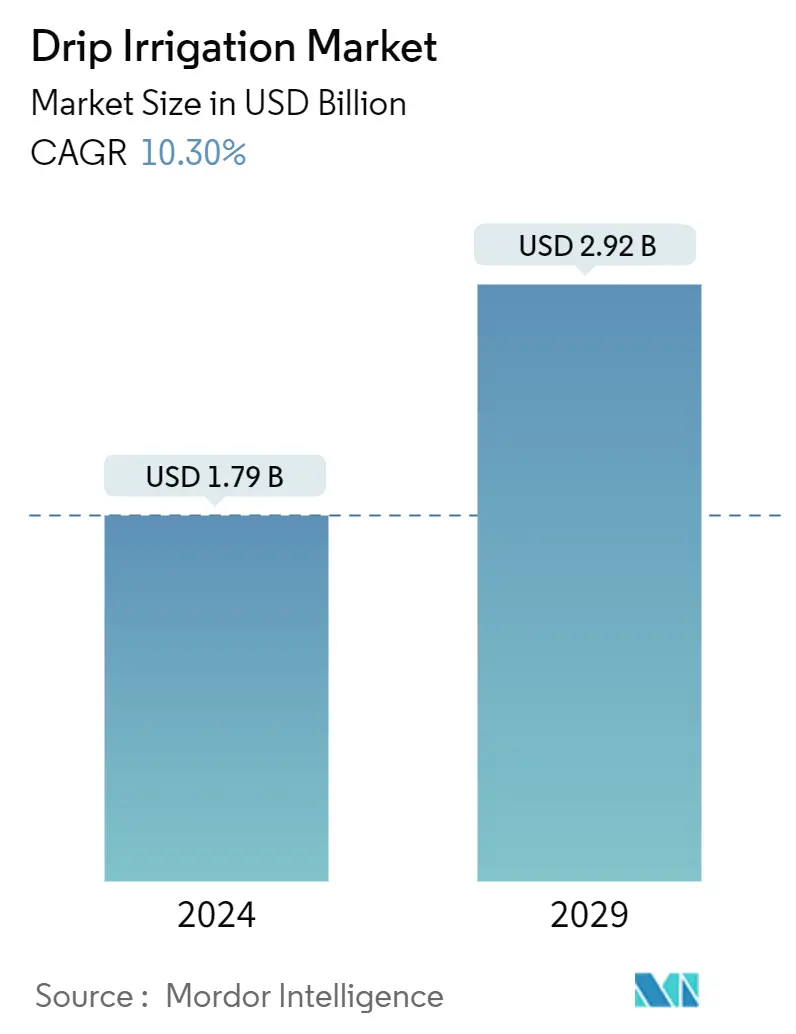Market Size of Drip Irrigation Industry

| Study Period | 2019 - 2029 |
| Market Size (2024) | USD 1.79 Billion |
| Market Size (2029) | USD 2.92 Billion |
| CAGR (2024 - 2029) | 10.30 % |
| Fastest Growing Market | Asia Pacific |
| Largest Market | Asia Pacific |
Major Players.webp)
*Disclaimer: Major Players sorted in no particular order |
Drip Irrigation Market Analysis
The Drip Irrigation Market size is estimated at USD 1.79 billion in 2024, and is expected to reach USD 2.92 billion by 2029, growing at a CAGR of 10.30% during the forecast period (2024-2029).
Irrigation is a critical component of agriculture and crop production. Manufacturers have created equipment and techniques to provide farmers with paramount drip irrigation systems. Factors such as government subsidies and policies, technological innovations, and increasing concerns over water scarcity drive the market. In recent years, drip irrigation implementation has increased in different regions. The Asia-Pacific has the largest market for drip irrigation systems. India is the largest market in Asia-Pacific for drip irrigation. The major market players operating in the drip irrigation systems market are focusing on strategic planning, product development activities, and mergers and acquisitions. For instance, in February 2024, the Saudi Drip Irrigation Company, a subsidiary of Mayar Holding, collaborated with the American firm Hunter Industries to design drip irrigation products for a broad spectrum of applications, including agriculture, residential, commercial, and golf courses. The collaboration seeks to transcend conventional manufacturing, focusing on developing innovative water and energy-saving solutions and custom manufacturing within the irrigation sector.
Drip Irrigation Industry Segmentation
Drip irrigation is a method of crop irrigation that helps save water and nutrients by allowing water to drip slowly to the roots of plants, either from above the soil surface or buried below the surface through a system of pipes, valves, tubing, and emitters. The Drip Irrigation Market is Segmented by Application (Surface Drip Irrigation and Subsurface Drip Irrigation), Crop Type (Field Crops, Vegetable Crops, Orchard Crops, Vineyards, and Other Crops), and Geography (North America, Europe, Asia-Pacific, South America, and Middle East & Africa). The report offers market size and forecasts in terms of value (USD) for all the above segments.
| Application | |
| Surface Drip Irrigation | |
| Subsurface Drip Irrigation |
| Crop Types | |
| Field Crops | |
| Vegetable Crops | |
| Orchard Crops | |
| Vineyards | |
| Other Crops |
| Geography | ||||||||
| ||||||||
| ||||||||
| ||||||||
| ||||||||
|
Drip Irrigation Market Size Summary
The drip irrigation market is experiencing significant growth, driven by the increasing need for efficient water management in agriculture. This growth is supported by government policies, technological advancements, and heightened awareness of water scarcity issues. The Asia-Pacific region, particularly India, leads the market due to its large agricultural base and the pressing need for sustainable farming practices. Major players in the industry are focusing on strategic collaborations and product innovations to enhance their market presence. For example, partnerships like that of the Saudi Drip Irrigation Company and Hunter Industries aim to develop advanced irrigation solutions that cater to various sectors, including agriculture and residential areas. The adoption of automatic drip irrigation systems is also on the rise, as they offer precise control over soil moisture, thereby improving crop yields and reducing resource wastage.
The market is further bolstered by the growing adoption of micro-irrigation systems and modern farming technologies, which are crucial for addressing food security concerns in densely populated countries like India and China. Initiatives such as Netafim's efforts in India to boost tomato yields exemplify the proactive steps being taken to enhance agricultural productivity through drip irrigation. The global market is characterized by a few dominant players, such as Netafim Limited and Jain Irrigation Systems Limited, who are expanding their product offerings and engaging in strategic partnerships to maintain their competitive edge. These developments underscore the industry's commitment to sustainable agricultural practices and the efficient use of water resources, aligning with global trends towards environmental conservation and resource optimization.
Drip Irrigation Market Size - Table of Contents
-
1. MARKET DYNAMICS
-
1.1 Market Overview
-
1.2 Market Drivers
-
1.2.1 Threat of Water Scarcity
-
1.2.2 Favorable Government Policies and Subsidies
-
-
1.3 Market Restraints
-
1.3.1 High Initial Capital Investments
-
-
1.4 Porter's Five Forces Analysis
-
1.4.1 Threat of New Entrants
-
1.4.2 Bargaining Power of Buyers/Consumers
-
1.4.3 Bargaining Power of Suppliers
-
1.4.4 Threat of Substitute Products
-
1.4.5 Intensity of Competitive Rivalry
-
-
-
2. MARKET SEGMENTATION
-
2.1 Application
-
2.1.1 Surface Drip Irrigation
-
2.1.2 Subsurface Drip Irrigation
-
-
2.2 Crop Types
-
2.2.1 Field Crops
-
2.2.2 Vegetable Crops
-
2.2.3 Orchard Crops
-
2.2.4 Vineyards
-
2.2.5 Other Crops
-
-
2.3 Geography
-
2.3.1 North America
-
2.3.1.1 United States
-
2.3.1.2 Canada
-
2.3.1.3 Mexico
-
2.3.1.4 Rest of North America
-
-
2.3.2 Europe
-
2.3.2.1 Germany
-
2.3.2.2 United Kingdom
-
2.3.2.3 France
-
2.3.2.4 Russia
-
2.3.2.5 Spain
-
2.3.2.6 Rest of Europe
-
-
2.3.3 Asia-Pacific
-
2.3.3.1 India
-
2.3.3.2 China
-
2.3.3.3 Japan
-
2.3.3.4 Rest of the Asia-Pacific
-
-
2.3.4 South America
-
2.3.4.1 Brazil
-
2.3.4.2 Argentina
-
2.3.4.3 Rest of South America
-
-
2.3.5 Middle East & Africa
-
2.3.5.1 United Arab Emirates
-
2.3.5.2 Saudi Arabia
-
2.3.5.3 Rest of the Middle East & Africa
-
-
-
Drip Irrigation Market Size FAQs
How big is the Drip Irrigation Market?
The Drip Irrigation Market size is expected to reach USD 1.79 billion in 2024 and grow at a CAGR of 10.30% to reach USD 2.92 billion by 2029.
What is the current Drip Irrigation Market size?
In 2024, the Drip Irrigation Market size is expected to reach USD 1.79 billion.

